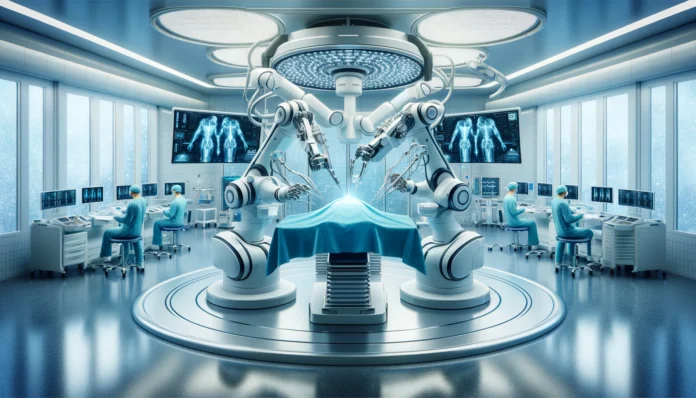In the rapidly evolving landscape of modern healthcare, technological advancements continue to revolutionize the way medical procedures are performed. Among these innovations, robotics has emerged as a pivotal tool in surgical interventions, offering precision, efficiency, and improved patient outcomes. With its ability to augment the skills of human surgeons, robotics is reshaping the future of surgery, paving the way for minimally invasive techniques and enhanced patient care.
Robotic-assisted surgery, also known as robot-assisted surgery or robotic surgery, involves the use of robotic systems to aid surgeons in performing complex procedures with greater accuracy and control. These systems typically consist of robotic arms equipped with surgical instruments, guided by a surgeon who operates from a console, controlling the movements with high precision.
One of the key advantages of robotic surgery is its ability to minimize invasiveness, thereby reducing trauma to the patient’s body and facilitating faster recovery times. Traditional open surgeries often require large incisions, leading to prolonged hospital stays and increased risk of complications. In contrast, robotic-assisted procedures involve smaller incisions, resulting in less blood loss, reduced pain, and shorter hospital stays for patients. This less invasive approach is particularly beneficial for delicate surgeries in areas such as the abdomen, thorax, and pelvis.
Moreover, robotics enables surgeons to perform intricate maneuvers with greater dexterity and accuracy than is possible with conventional techniques. The robotic arms are equipped with advanced instruments that can rotate and bend with a greater range of motion, allowing surgeons to access hard-to-reach areas and perform precise movements with sub-millimeter accuracy. This precision is especially critical in procedures involving delicate structures such as blood vessels and nerves, where even minor errors can have significant consequences.
Another significant advantage of robotic surgery is its ability to enhance visualization. Robotic systems are equipped with high-definition cameras that provide surgeons with a magnified, 3D view of the surgical site, allowing for better visualization of anatomical structures and improved surgical precision. This enhanced visualization enables surgeons to identify and address pathology more effectively, reducing the risk of complications and improving patient outcomes.
Furthermore, robotics facilitates remote surgery, allowing surgeons to perform procedures from a distance. This capability is particularly valuable in scenarios where specialized expertise is needed but not readily available locally. Through teleoperated robotic systems, surgeons can remotely control robotic arms and perform surgeries in real-time, providing access to advanced surgical care in underserved areas and improving patient access to specialized medical expertise.
The adoption of robotic surgery across various medical specialties has led to a growing body of evidence supporting its efficacy and safety. Numerous studies have demonstrated the benefits of robotic-assisted procedures, including reduced operative times, lower complication rates, and improved patient satisfaction. As a result, robotic surgery has become increasingly prevalent in fields such as urology, gynecology, colorectal surgery, and cardiothoracic surgery, among others.
Despite its numerous advantages, robotic surgery also presents challenges and limitations. The high cost of robotic systems and the associated maintenance expenses can pose barriers to widespread adoption, particularly in resource-limited settings. Additionally, the learning curve for surgeons transitioning to robotic-assisted techniques can be steep, requiring extensive training and proficiency in operating the robotic console. Moreover, technical issues such as system malfunctions or connectivity issues can potentially impact surgical workflow and patient outcomes.
In conclusion, robotics plays a crucial role in modern healthcare by revolutionizing surgical practices and improving patient care. Through its ability to enhance precision, minimize invasiveness, and facilitate remote surgery, robotics has transformed the way complex procedures are performed, offering new possibilities for innovation and advancement in the field of surgery. As technology continues to evolve, the integration of robotics into surgical practice is poised to further expand, driving continued improvements in patient outcomes and shaping the future of healthcare.





